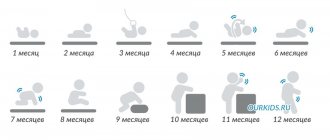At five months, another leap occurs in the baby’s development, requiring special attention from parents and leading to changes in the family’s lifestyle.
The baby begins to roll over from back to tummy and back; begins to actively hum, pronouncing the first syllables - often consciously; is actively interested in the outside world, holds toys, is able to respond emotionally to music and - finally - can sleep through the night without waking up to feed.
What should a baby be able to do at five months of age?
By five months, both girls and boys can already do a lot. The most important thing is that the baby develops awareness , he is actively interested in the world around him, looks at toys and bright books, grabs objects and tastes them, reacts emotionally to the voice of his family, his favorite music, and laughs when they play with him.
The child actively hums, draws out sounds, can pronounce clearly defined syllables (pa-pa, ma-ma, dyad-dya), in some cases - whole words.
He tries to sit up, turns over, “rakes” with his arms and legs, lying on his stomach - getting ready to crawl. Some babies begin to crawl by five to five and a half months.
Important! As soon as the baby begins to roll over from his back to his stomach, you should not leave him alone on a bed without sides, even for a couple of minutes. The baby may roll from the middle of the bed and fall to the floor. We always place a sleeping child in a crib, and a awake child on the floor or in a playpen.
If you place a toddler on a hard surface, holding him by the arms, he will stretch out his legs, trying to stand or even take a step.
A child can clench an object in his fists, bring it to his face, examine it with obvious pleasure, transfer the object from hand to hand, and give preference to some toys over others.
The baby is showing the first signs of independence - he happily holds a bottle of formula or water and feeds himself.
On our website there are also articles about the next months of the baby’s life, such as , , , , , , , months.
Psychological development
- The baby's babble becomes more intelligible; these are no longer primitive individual sounds, but a combination of them: “ma”, “nya”, “da”, “ba”. The child pronounces them, repeating them several times in different combinations, producing something like a pipe.
- The baby sometimes “talks” to himself, clearly separating syllables.
- Distinguishes between strict and gentle intonation. May be offended when people swear at him or shout at him. He becomes silent when people talk to him, listening carefully. Trying to attract attention.
- The child easily recognizes familiar faces and becomes wary at the sight of new people. Reacts to facial expression. Captures connections between hairstyle, eyes, voice, and remembers the image as a whole. Likes to look at images of faces in pictures, prefers smiling ones.
- Even if the baby seems sociable in the presence of his mother, then without her, next to strangers, he becomes fearful.
- In the fifth month, the ability to visually control hand movements improves: the baby can easily pick up the desired object by looking at it.
- So far he cannot find a toy covered with something, but if it is not completely covered, the child will understand where it is hidden.
- Some children may already remember the qualitative characteristics of objects, for example: the color or size of a toy, what it feels like, and prefer these things to others.
- By the beginning of the 6th month, the baby can not only grab and hold a toy, but also pull it towards himself and take it away.
- The child can now devote 5 to 10 minutes to independent play.
If the child does not have some skills (see 4 months), then it is necessary to consult a pediatrician.
Features of nutrition of five-month-olds
For babies who are fully breastfed, nutrition does not change, since complementary foods are introduced only after a month.
If the pediatrician believes that the child does not have enough milk due to a rapid growth spurt and increased physical activity, he may recommend introducing porridge into the diet, replacing one feeding with it.
If you have constant problems with stool, that is, constipation, you can start introducing vegetable puree - without salt, oil and spices, according to a scheme agreed with your doctor.
For bottle-fed children, porridge and vegetable puree are added to the diet. Of the standard five feedings, three consist of the usual formula, one feeding includes porridge, and one includes vegetables.
Important! Five-month-old babies do not need fruits, juices, or egg yolks. Introducing fruits is postponed until the child is at least 8 months old, and the yolk until he is nine to eleven months old.
Physical development of a child at 5 months
At 5 months, the baby usually gains another 750 g and grows by about 2.5 cm. The chest circumference increases and begins to exceed the head circumference. Remember that each baby develops at its own pace, but it is necessary to know the average indicators of physical development in order to determine whether your child is growing normally and whether additional consultation with a specialist is needed.
For this purpose, the calculation of the normal weight and height of a child by month is often used according to WHO (World Health Organization) recommendations. These indicators characterize the health and level of physical development of the baby.
Below are the norms of physical development for a five-month-old baby depending on gender.
Indicators of physical development of a child at 5 months
| Index | Average at 5 months | Boys at 5 months | Girls at 5 months |
| Weight | 6900-7500 g | 6000-9300 g | 5400-8800 g |
| Height | 64-65.9 cm | 61.7-70.1 cm | 59.6-68.5 cm |
| Head circumference | 41.5-42.6 cm | 40.1-45 cm | 38.9-44 cm |
| Chest circumference | 42.4-42.9 cm | 40.1-45.7 cm | 40.3-44.5 cm |
You can use an online calculator to calculate the norms for your child . The calculator is based on height and weight standards from the World Health Organization (WHO) and calculates normal physical development values for a five-month-old child.
Psychology
At this age, the baby experiences an active leap in understanding the speech of an adult and in the sounds he makes .
A five-month-old toddler already knows whether his mother is talking to him kindly or angry, cheering him up or urging him to concentrate.
“Walking” becomes conscious, the child is able to pronounce the first syllables, in some cases, words addressed to a specific person or associated with an object (for example, a favorite toy).
The baby recognizes mom, dad and other people who are with him constantly, and begins to be wary of strangers. The attachment to the mother not only does not weaken, but also intensifies - it is at this age that babies can literally “not get off their hands,” demanding constant attention.
The toddler begins to actively show emotions - he laughs, rejoices, smiles (find out in more detail when a child begins to smile), gets offended, gets angry - sometimes very actively, and the transition from one emotion to the opposite can take several seconds.
Attracts mother's attention consciously by crying, pushing toys or crib bars with her feet.
Recognizes objects - identifies favorite toys, actively reaches out to them, is able to choose the brightest or most familiar one from several objects.
Approximate daily routine
At five months, many babies experience a very important stage for their mother - they stop waking up for night feedings and can finally sleep at night for 9-10 hours straight.
Otherwise, the daily routine differs little from that of a four-month-old baby. This is the same five hours of daytime sleep and ten hours of sleep, but the time of wakefulness increases - the child may not sleep for about two hours in a row, demanding attention, playing, entertaining himself on his own.
At this age, it is necessary to increase the time for gymnastics, develop the baby’s fine motor skills, read him fairy tales, nursery rhymes, sing songs, and play music.
Be sure to take your little one for a walk twice a day , and on the second walk you can put him in a sling - let the child begin to explore the world.
The daily routine of children at this age may be different, but it is worth sticking to the established routine - this way the child will sleep better, eat better and develop more actively.
An approximate regimen for a five-month-old baby is as follows:
- 8:00 Awakening from a night's sleep, first feeding (milk or bottle with formula), cleaning ears and nose, washing face.
- 10:00 First nap.
- 11:30 Awakening, second feeding (porridge for artificial babies), active games with mom, exercises or massage.
- 13:30 Walk in the stroller, nap outside.
- 14:30 Third feeding - the artificial baby is given vegetable puree.
- 15:30 Games with the baby, massage, gymnastics on the ball.
- 17:00 Walk and last nap outside.
- 18.00 Return home, fourth feeding, quiet games. During this period, you can leave the baby alone, giving him a rattle - he is quite capable of keeping himself busy for up to half an hour.
- 20:00 Bathing in a large bath, activities with the baby in the water.
- 20.30 Fifth feeding, bedtime.
Formula-fed babies wake up at 12 or 1 am to get a bottle of formula; infants may well wake up several times a night to eat. But in some cases, the child can sleep peacefully until the morning.
Care and hygiene
Boys
Babies at five months begin to actively move, roll over, pull toys into their mouths, reach their faces with their feet, and suck their fingers.
Hygiene at this time becomes especially important - you need to cut the nails on the hands and feet at least twice a week so that the little one does not scratch himself, and wash toys with baby soap.
As before, you need to bathe your little boy every day, clean his ears and nose, change his diaper regularly, washing the baby before each change.
Some boys at this age begin to crawl, so special attention should be paid to the safety of the room - close the sockets, remove small objects from the floor, wash the floors thoroughly, preferably daily.
Girls
Caring for a five-month-old girl is not much different from caring for a boy. Girls begin to roll over and crawl a little later, so you can worry about home safety a month later. The rest of the rules are the same - thoroughly washing and pouring boiling water over toys, wiping the sides of the crib with warm water and soda.
Many babies begin teething at this time. Teether toys should be washed with warm water and baking soda several times a day, after washing, rinse thoroughly and wipe with a dry, clean towel.
Gymnastics
Playing sports at this age brings extraordinary pleasure to the baby. To the daily massage of the back, tummy and legs, you can add stretching of the arms, crossing them, bending and unbending the legs, kneading the feet (very soft), and finger massage.
If the child is not yet turning over, you need to help him by gently supporting him under the back and stomach, slightly pushing him in the right direction.
You can stimulate physical activity by placing the baby on his stomach and placing a bright toy near him - the little one will try to reach it, trying to crawl.
Facial expressions and speech
It’s too early to talk about speech yet. Five-month-old babies do not speak, even if you clearly heard the treasured “mom”. The child is just babbling. He doesn’t associate “ma-ma” with you in any way; for him it’s a set of sounds. But this is exactly how he develops his speech apparatus to pronounce real words in the future.
The baby’s facial expressions undergo more serious developmental changes. At this age, children not only whine, they can smile and even make eyes at their mother. It's nice and it's convenient. The baby is already reaching for what he wants - here are the first gestures. And when she cries, by the expression on her face, the curve of her eyebrows and lips, the mother will easily understand: these are whims, or something is really wrong. The baby doesn’t know how to be cunning yet; his facial expressions give him away. But that's good.
Don’t be shy about making faces at your baby; sooner or later he will happily start repeating after you. The development of facial expressions at five months is the key to the charisma of an adult.
Classes
Preparing your baby's back for future stress
At the age of five months, the back needs to be prepared for heavy loads . A little more - and the baby will begin to sit up, crawl, and then stand up, holding on to the side of the crib.
The back is strengthened with massage (not only stroking, but also patting, light tapping, pinching) and exercises on a ball and in the bath.
If a child before this age bathed in a small bath, you can transfer him to a large one. By supporting the baby in the water under the back and tummy, stimulating him to roll over in the water, you can strengthen the back muscles.
Exercises on a large ball - tummy rolls - are also very useful.
Several times a day you need to do a simple exercise - spread the toddler’s arms to the sides, cross them and spread them again - at least 20 approaches at a time.
Fine motor skills
The development of fine motor skills is extremely useful for the baby. At five months, you can let your little one sort out large beads, put objects of different weights, sizes and materials into the hands - rough, smooth, soft.
It is useful to let your baby hold a scarf or rope in his fist and pull it out very carefully.
You can sew large buttons, smooth wooden cubes, various pieces of fabric (velvet, silk, large lace) onto a large piece of fabric, put the child on his tummy and let him examine and touch this homemade toy.
Very small objects (cereals, beads, seeds) are not given to five-month-olds, as this is unsafe even in the presence of an adult.
Communication and tactile contact
Since at this age the child begins to understand speech, emotions and consciously pronounce sounds, you need to communicate with him all the time he is awake. Nursery rhymes, songs, fairy tales, just talking with your baby are very useful for his development.
When showing your child toys or objects, you need to pronounce their names, address the child by name as often as possible, and hum along to the music.
Some children at this age are extremely attached to adults and need constant tactile contact. Do not leave the baby alone for a long time; he needs constant stroking and regular massage. Formula-fed babies should be held even more often than infants, since they especially lack physical contact with their mother.
Getting to know the book
Five months is a great time to start reading books, as at this age babies begin to take a keen interest in pictures.
Books with bright letters and large, bright images of animals, plants and toys should be shown, naming the characters drawn, pronouncing the words slowly and clearly. Many children love books and bath toys.
Just try to make sure that the little one does not chew the corners - this will not do him any good.
What games, toys can you use and cartoons to watch?
At this age, the mobile and hanging rattles are removed from the crib - the child can reach them, tear off part of the toy and put it in his mouth.
The best toys are large plastic, high-quality, smooth wooden and soft textile ones that are easy to wash.
They need daily washing and treatment - this must be taken into account when purchasing.
For a five-month-old baby, you can buy musical toys that respond to action - with buttons and strings.
The baby will quickly understand that his action causes a certain melody, and will be happy to practice.
Note! At the age of five months, you can put the child in a special chair and for a short time - no more than ten minutes - play him a cartoon with bright characters and recognizable heroes, with a memorable melody (old Soviet ones work well).
Common problems at this age and how to solve them
The main problems at five months of age are:
- injuries due to falls and impacts on large furniture after the child began to roll over and crawl;
- digestive problems due to the introduction of complementary foods too early;
- increased moodiness, fever, irritability, poor sleep due to the onset of teething.
To prevent such problems from arising, it is necessary to prepare for this period:
- Secure the house, buy a playpen, place the baby on his tummy on the floor and not on the bed, and do not leave him alone.
- Before introducing complementary foods, consult your doctor and under no circumstances rush.
- Buy teethers, special gel for gums.
Nutrition and sleep
A child's sleep and wakefulness patterns at 5 months remain the same as last month (see 4 months). For each baby it is individual and depends on biorhythms and temperament: some wake up early and go to bed the same way, while others like to get up later and “walk” half the night. Babies can still confuse day with night, but many children already sleep longer at night than during the day, waking up 1-2 times.
Feeding remains unchanged for now (see 4 months). Continue breastfeeding or formula feeding as required.
At 5 months, the introduction of the first complementary foods is allowed if:
- You don't have enough milk;
- The child does not gain weight well, is capricious, and does not eat enough;
- He is tormented by abdominal pain or constipation, rare or scanty stools;
- He burps frequently (more than 2 times a day or after each feeding).
In any of these cases, consult your pediatrician so that he can determine that the cause is indeed malnutrition and select the first complementary foods.
We are reading: About the first feeding and an important article about the daily routine of a child at 5 months
← 4 month 6 month →










